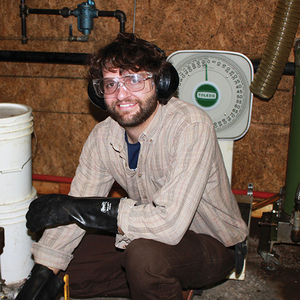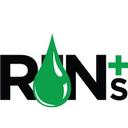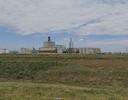Safety Your Way

PHOTO: KELLEY GREEN BIOFUEL
November 11, 2014
BY Ron Kotrba
A philosophical problem exists when an industry whose mission is to improve humanity through environmental stewardship and creation of war-free fuel has a notoriously poor safety record—one that puts workers and nearby residents at risk. “Biodiesel is critically important for our economy and environment, but it must be manufactured safely at all scales of production for its benefits to be realized,” says Kristopher Kelley, founder and CEO of Kelley Green Biofuel, a farm-based biodiesel operation in Goshen, Kentucky.
Lyle Estill, president of Piedmont Biofuels in Pittsboro, North Carolina, says safety is a culture. “When you change the stories, you change the culture,” he says. “Constantly telling the stories of safe operation is not as dramatic as telling the stories of danger and close calls, but both are critically important. Making fuel is hot, heavy, smelly, greasy, dangerous work, and it is imperative that everyone understand that up front.”
Methanol is clearly the most dangerous chemical culprit at biodiesel facilities, and therefore it is also the biggest concern when designing and operating a plant safely. “It is an explosion hazard, an environmental hazard and a hazard to humans due to its toxicity,” says Derek Masterson, biodiesel product sales manager with Crown Iron Works. “As with any processing plant, the issue comes down to the customer’s safety mindset, and this trickles down to the operators.”
CIW has designed a number of large-scale biodiesel plants all over the world. The company uses sealless pumps when the liquid being pumped contains methanol, or may contain methanol in a plant upset condition. CIW also designs plants to operate at the lowest temperature and pressure economically feasible. It employs motors and instrumentation classified as intrinsically safe or explosion-proof. Vessels that contain methanol, or may contain it in a plant upset, are blanketed with nitrogen. “These same vessels are connected to a common header and vent stack in order to quickly evacuate methanol vapor in case of overpressure resulting from a process upset or extra heat and pressure added due to a fire,” Masterson says. The control system includes the appropriate visual and audible alarms for conditions that would cause concern, such as high temperature or pressure, or low cooling water flow. “We also recommend the installation of floors and drains so that methanol cannot pool and concentrate,” he adds. “We recommend the use of methanol vapor detectors at strategic points throughout the building. This is usually done in conjunction with local authorities and the customer’s insurance company. Again, per local authorities and insurance, we recommend the customer find a way to vent the building in the case of the detection of a high level of methanol.”
Process technology provider WB Services also installs nitrogen blankets on tanks that have methanol in sufficient quantities to cause a flammable environment. Ron Beemiller, president and CEO, says they employ methanol recovery to collect vapors vented off the process tanks, and fusible link valves on tanks that have biodiesel and methanol in them so they don’t feed a fire. The process building also contains a sprinkler system. “In addition to standard NFPA requirements, fire protection equipment is generally dictated by insurance provider requirements,” he says. “That said, it’s highly recommended that, at a minimum, plants integrate a sprinkler system, nitrogen blankets on critical tanks, as well as coordinate with local fire departments to maintain a supply of the proper foam product.” The nitrogen system and ensuring oxygen concentration is maintained below the lower explosive limit are paramount to plant safety, he adds.
Kelley says safety practices at his facility have greatly improved since he first started making biodiesel in 2008, thanks in part to process consultant Link Shumaker. “He has had a lot of experiences at other plants regarding plant safety, both good and bad,” Kelley says. “We tried to pull together some best practices for how we operate at Kelley Green.”
For making methoxide, KGB uses a totally closed vessel with an air-powered mixer. Though the facility is well ventilated, Kelley says before installing the methanol vent system, methanol could be smelled in the air during certain parts of the process. He uses a personal methanol meter by Drager to help determine exposure points, giving alarms at 10 and 20 ppm, below the level that can be smelled. “If you can smell methanol, it's too much to be exposed to for extended periods of time,” Kelley says. “Our ventilation system drastically reduced the readings in the production facility.”
Advertisement
Kelley and Shumaker designed a methanol vapor ventilation-recovery system at KGB. “We built the system with a hazardous location fan and PVC tubing,” Kelley says. “In order to dissipate electrical charges inside the plastic vent lines, we ran stainless bonding wire throughout the system.” All tanks that contain methanol or methanol vapor are grounded. The process moves methanol by vacuum rather than using multiple hazardous location pumps and motors. KGB also has a book of Standard Operating Procedures that describes how to do each task safely. Also, the plant’s personal protection equipment (PPE) is located in a central location where personnel know to find it.
Estill says Piedmont has moved from being “lackadaisical to religious” about maintaining a ready supply of PPE. Now, face masks, ear plugs, gloves, respirators, aprons, harnesses, hard hats, welding masks and more are available for operators in every building. “For these items to be readily used, they need to be readily accessible and in good working order,” Estill says. “That's easier said than done—since plastic cracks, and items become grease-ensconced and unusable. Keeping a fleet of PPE in order requires constant attention and investment.”
Piedmont has a safety committee that routinely walks the plant and makes recommendations for change or improvement. “We have a constant list that is regularly updated,” Estill says. The plant’s sprinklers, exit signs and fire extinguishers are also inspected annually, and a plantwide siren alarm is utilized for periodic fire drills.
In 2014, Pacific Biodiesel’s Big Island Biodiesel facility began a major effort to revamp and thoroughly examine the safety program in place at the plant in Keaau, including a complete update of its Process Safety Management program. “Whenever changes to any portion of a process are amended, these standards and our in-house PSM need to be reviewed and a management of change is completed,” says Michael Heinemann, director of operations for Pacific Biodiesel Technologies. The plant segregates all methylated materials, equipment and systems into a Class I Division II area that utilizes intrinsically safe equipment and an enclosed vapor recovery system to blanket all process vessels with inert nitrogen gas to minimize the chance of any flammables or combustibles igniting. “This area is surrounded in its entirety by a containment wall to prevent any spilled materials from being released to surrounding areas or the environment,” he adds. “All laborers in our industry have the right to a safe work environment, and we strive to ensure our employees have the knowledge and information available to determine on their own whether their work environment is safe or not.”
Automation is also essential, Heinemann says, to ensure critical components be controlled quickly to facilitate safe, steady-state operating parameters, and to allow operators to do this remotely from a safe vantage point outside the hazardous area. Since operations began, the facility has procured various air monitoring equipment to ensure a safe atmosphere for employee exposure. Volatile Organic Compound meters are used for industrial hygiene, leak detection and HazMat response. Heinemann says since annual rainfall can exceed 12 feet of rain per year, raised grating was installed within the containment areas.
Training and Maintenance
No one, including interns, starts work at Piedmont without first reading its Health and Safety manual. Every new employee gets a hazardous material and safety walk through, and new employees are unable to perform certain tasks without completing training such as confined space entry or forklift operation. Employees certified in these tasks watch a video on each one every year as a refresher, Estill says.
WB provides an in-house, three-day training at its Green Energy Products biodiesel plant in Sedgwick, Kansas. Plant operators participate in a classroom setting where SOPs are reviewed in detail, including the proper PPE for each procedure. “Specifically, the methanol recovery process and establishing a nitrogen blanket are standalone SOPs that are reviewed in depth,” Beemiller says. “In addition to the classroom setting, operators participate in hands-on exercises that always highlight the safety components of each process.”
Advertisement
CIW educates its customers on the hazards of methanol and why plant safety is important. “We discuss the safety features of the plant,” he says. “We talk about startup and shutdowns. We discuss many of these issues before the plant is delivered so that the equipment outside our scope, such as fire suppression, methanol detection and vent fans, is included in the building design from the beginning. We make the point that a trained staff is essential to smooth and safe operation.”
The first step for a new employee at BIB is becoming familiar with its Emergency Action Plan and being issued the appropriate PPE. The EAP details an expedited emergency shutdown procedure, “which is as simple as pushing a single button to initiate a full, controlled plant shutdown with no plant operators necessary,” Heinemann says. After this, the employees are provided with OSHA Outreach Training that focuses on general industry, American Heart Association Heartsaver First Aid/CPR/Automated External Defibrillator, and Hazardous Waste Operations and Emergency Response awareness training. Heinemann says the facility employs an on-site safety coordinator in conjunction with safety officers on every shift. “Education and training are absolutely necessary to ensuring that proper work practices are being followed,” Heinemann says.
Preventative maintenance is safety, according to Heinemann. “If the integrity of the systems used to process biodiesel is in question, then everyone’s safety is in question,” he says. Leaking seals of pumps transferring flammable or combustible materials can lead to fires. Loose hardware on a flange that is backing off due to equipment vibrations can lead to gaskets blowing out and potential injury.Ensuring proper operation of pressure-sensing and pressure-relief valves can prevent a vessel from rupturing or imploding. “Safe working practices are an integral part of maintenance,” Heinemann says. “Hot work permit requirements, confined space permit requirements, PPE and job hazard analysis are some of the things that ensure maintenance is performed safely.”
Estill says Piedmont routinely shuts down in slow periods for maintenance to ensure smooth and safe operation for the high production periods. “Biodiesel plants are at their most dangerous when construction and hot work is underway,” he says. Since designs are constantly changing and improving, plants are frequently “under construction” even while fuel is still being produced. “Stop production during plant modifications,” advises Estill. “I am constantly relieved when the welding and grinding equipment is collecting dust.”
Every safety system has its own maintenance schedule determined by its manufacturer. “This is what we recommend as a starting point,” Masterson says. For example, methanol detectors must be checked for effectiveness, and vent fans and eye-washing stations should be tested. “We would not recommend ignoring any maintenance, as all items are important to a safe plant,” he says. While drips and leaks may seem like minor occurrences, Beemiller says they are a major concern from a maintenance and safety perspective. “Pools of methanol or biodiesel left alone will be huge slip and fall, and fire hazards,” he says. “Biodiesel is known to be susceptible to spontaneous combustion under the right conditions, and plants must be vigilant on repairing leaks and properly disposing of rags, filters and other materials that have been used in cleanup of leaks.”
“Maintenance and safety are certainly connected, as failing equipment can certainly be a safety hazard,” Kelley says, adding that with a small facility, it’s manageable to check over equipment daily. “We try to lubricate gear boxes and bearings on regular intervals,” he says. “There is very little automation in the plant, so the operator generally knows when something starts to act unusually or needs attention.” He adds that a good inventory of spare parts and backups are essential so small maintenance issues can be resolved without delaying a batch.
Vice president of Pacific Biodiesel Kelly King says, ultimately, commercial-scale biodiesel production requires a high level of increased safety procedures and equipment that must be an integral part of the budget and SOPs. “If you feel something is not safe, speak up,” says BIB Safety Officer Joe Kashuba. “Safety is everyone’s responsibility.”
Author: Ron Kotrba
Editor, Biodiesel Magazine
218-745-8347
rkotrba@bbiinternational.com
Related Stories
Biodiesel capacity in the U.S. and Canada dipped slightly stable in 2024, with several renewable diesel producers reporting headwinds and lower margins alongside a drove of SAF projects in various stages of development.
The IEA’s Task 39 group has new research regarding the development and status of the sustainable aviation fuel industry.
The U.S. EPA on Nov. 16 released updated RIN data, reporting that nearly 2.11 billion RINs were generated under the RFS in October, up from 1.81 billion generated during the same month of last year.
Conestoga to host SAFFiRE cellulosic ethanol pilot plant
Conestoga Energy and SAFFiRE Renewables LLC announced on Nov. 16 their agreement for Conestoga to host SAFFiRE’s cellulosic ethanol pilot plant at Conestoga’s Arkalon Energy ethanol facility in Liberal, Kansas.
Officials at Calumet Specialty Products Partners L.P. discussed the company’s proposed plans to boost sustainable aviation fuel (SAF) production at its Montana Renewables biorefinery during third quarter earnings call, held Nov. 9.
Upcoming Events










